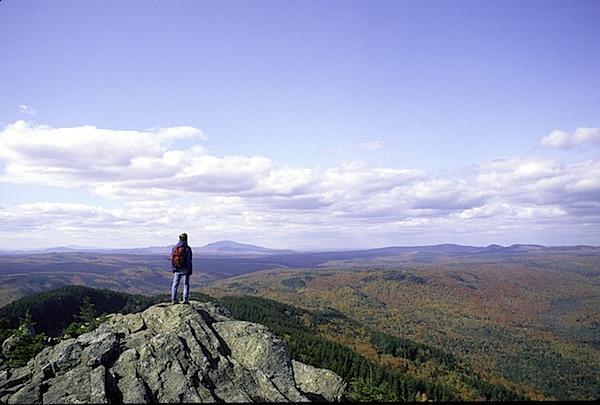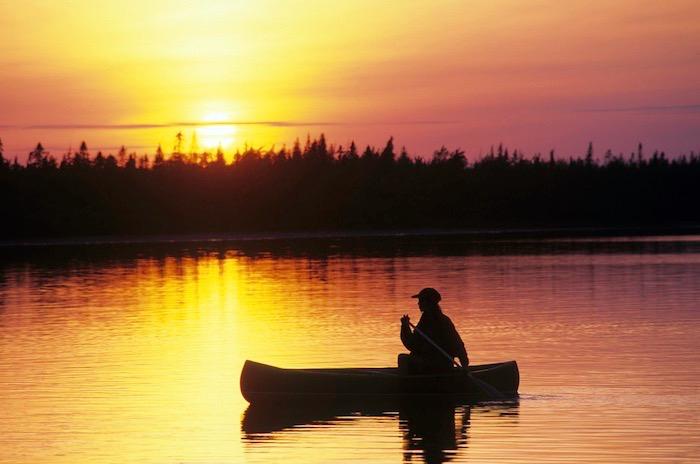
President Obama has designated a new national monument in Maine's North Woods/George Wuerthner
Editor's note: This updates with reaction from the National Parks Conservation Association, U.S. Rep. Rob Bishop, and the Center for Western Priorities.
A wide, wild swath of Maine's North Woods on Wednesday became the country's newest national monument, as President Obama used his authority under The Antiquities Act to designate Katahdin Woods and Waters National Monument.
Just a day after Elliotsville Plantation, Inc., transferred nearly 90,000 acres of private lands to the Interior Department, the president designated the first national monument to preserve the landscape and honor the history and culture of Maine’s North Woods. His action came a day before the National Park Service marked its 100th birthday. Within the landscape is the East Branch of the Penobscot River and its tributaries, one of the most pristine watersheds in the Northeast, a release from the Interior Department said.
“One hundred years ago, President Woodrow Wilson designated Sieur de Monts National Monument, now known as Acadia National Park. It was protected for its rich history, scientific interest and landscape beauty. The same can be said about Katahdin Woods and Waters National Monument," said Theresa Pierno, president and CEO of the National Parks Conservation Association. "This land is truly deserving of national park status and protection. It has vast boreal forests, abundant wildlife and flowing rivers that are all idyllic and so uniquely Maine. Now families across the country and around the world will be able to go hiking, horseback riding, skiing and fishing in this incredible area for generations to come."
But the president's action was quickly derided by U.S. Rep. Rob Bishop, R-Utah, who said it smacked of favoritism to "elite, special interests."
“The President is using the (National Park Service) Centennial as a cover to subvert the will of Maine’s citizens and leaders. The only votes taken on this proposal, at the local and state level, have demonstrated opposition from Mainers," the congressman said in a release. "If the President cared about local voices and improving our National Park System, he would have done this through the public process and not behind closed doors. Instead, he’s hijacked a moment of celebration to advance powerful elite special interests over Maine’s economy and citizens.”
But Rep. Bishop's reaction was quickly met by the Center for Western Priorities, where Deputy Director Greg Zimmerman said, "Our nation's newest national monument in the Maine woods reaffirms two bedrock American principles; private property rights and our system of parks and public lands are core to our national identity. And yet, the very week America celebrates the founding of our National Park System (sic), some politicians in Washington are demeaning and denying their value. But like the robber barons of yesteryear who opposed parks at the Grand Canyon and Yellowstone, Rep. Rob Bishop and his fellow conservation opponents remain on the wrong side of history.”
This weekend, Interior Secretary Sally Jewell will visit the national monument lands in Penobscot County, Maine, to celebrate the designation with state and local officials and members of the public. National Park Service staff will be on site to assist with the first steps to open the park.
“As the National Park Service begins a second century of conservation this week, the President’s designation of Katahdin Woods and Waters National Monument serves as an inspiration to reflect on America’s iconic landscapes and historical and cultural treasures,” said Secretary Jewell. “Through this incredibly generous private gift for conservation, these lands will remain accessible to current and future generations of Americans, ensuring the rich history of Mainers’ hunting, fishing and recreation heritage will forever be preserved.”
EPI is the nonprofit foundation established by Roxanne Quimby and run by her son Lucas St. Clair. Their gift of land is accompanied by an endowment of $20 million to supplement federal funds for initial park operational needs and infrastructure development at the new monument, and a pledge of another $20 million in future philanthropic support.
The new national monument – which will be managed by the National Park Service and is now the 413th park unit in the National Park System – is located directly east of the 209,644-acre Baxter State Park, the location of Maine’s highest peak, Mt. Katahdin (5,267 feet), the northern terminus of the Appalachian Trail. The boundaries of the new national monument also include 4,426 acres of private land owned by the Baskahegan Company, which requested inclusion should the company in the future decide to convey its lands to the United States or a conservation buyer, on a willing seller basis, for incorporation into the monument.
The Katahdin Woods and Waters National Monument designation is the result of a years-long effort by Ms. Quimby and her son. Ms. Quimby purchased the lands with a portion of the wealth she created as a co-founder of Burt’s Bees in 1984, and developed the idea of gifting the lands to the American people as part of the National Park System. St. Clair, raised in Maine and dedicated to preserving the landscape and access for recreational activities, and a small EPI staff, have been operating the lands as a recreation area for several years.
“The National Park Service marks its centennial this week with a renewed commitment to tell a more complete story of our nation and to connect with the next generation of park visitors, supporters and advocates,” said National Park Service Director Jonathan B. Jarvis. “I can’t think of a better way to celebrate the Centennial and underscore our mission than by adding this extraordinary piece of Maine’s North Woods to the National Park System, and sharing its stories and world class recreation opportunities with the rest of the world.”

The new monument is expected to continue to permit traditional uses of the area, such as snowmobiling, cross-country skiing, and hunting/George Wuerthner
The new national monument includes the stunning East Branch of the Penobscot River and a portion of Maine’s North Woods that is rich in biodiversity and known for its outstanding opportunities to hike, canoe, hunt, fish, snowmobile, snowshoe and cross-country ski. These and other traditional activities will continue to be available in the new national monument.
In addition to protecting spectacular geology, significant biodiversity and recreational opportunities, the new monument will help support climate resiliency in the region. The protected area – together with the neighboring Baxter State Park to the west – will ensure that this large landscape remains intact, bolstering the forest’s resilience against the impacts of climate change.
The new monument is also a storied landscape. Since the end of the last Ice Age 12,000 years ago, the waterways, wildlife, flora and fauna, night skies, and other resources have attracted people to the area. For example, the Penobscot Indian Nation considers the Penobscot River watershed a cultural and spiritual centerpiece and since the early 19th century, logging has been a way of life. Artists, authors, scientists, conservationists and others – including Teddy Roosevelt, Henry David Thoreau and John James Audubon – have also drawn knowledge and inspiration from the area’s resources.
National Park Service staff will hold a series of public listening sessions throughout the Katahdin region starting the week of September 12 to begin work on the management plan that will be developed during the first three years. Details of the listening sessions, including dates and locations, will be shared with local newspapers and posted to the monument’s website (). NPS’s planning will be done with full public involvement, with special emphasis on understanding the ideas and concerns of the local communities.
The approximately $100 million total gift to the American people from the EPI, was facilitated by the National Park Foundation as part of its Centennial Campaign for America’s National Parks.
“This extraordinary gift sets the stage for a strong and vibrant second century for America’s national parks,” said Will Shafroth, president of the National Park Foundation. “Through their vision and generosity, Ms. Quimby and her family are carrying on the philanthropic tradition from which the national parks were born 100 years ago, and which helped create Grand Teton, Acadia and Virgin Islands National Parks."



Comments
Good news! Rep. Rob Bishop from Utah won't be happy after traveling to Maine to hold a sham hearing to prevent the designation.
Excellent news! Now let's hope the President has enough gumption to do the same for Bears Ears in Utah.
Absolutely agree with Lee here.
Excellent, excellent news!
Glad to see you're still lurking out there, Justin;-)
What was the cash donation that will fund the maintenance of this new park unit?
$20 million, with another $20 million to be raised in three years, I believe. So a $40 millon endowment.
Kurt, just great news, so many thanks to Mrs. Quimby, her family, those that supported this effort and President Obama for making it a National Monument. More good news, Kurt, Alfred Runte, the Board of Supervisors voted down the Soda Mountain Industrial solar farm.